Medication Errors in Nursing: A Detailed Report and Analysis
VerifiedAdded on 2022/08/14
|5
|885
|15
Report
AI Summary
This report examines the critical aspects of nursing and medication administration, focusing on the 'nine rights' of medication administration as a framework for preventing errors. It analyzes a real-life case of a medication error, highlighting the consequences of non-compliance with these rights. The report includes an analysis of medication error rates, calculating the percentage of error within a healthcare organization and providing recommendations for policy revisions. The report emphasizes the importance of patient safety, proper documentation, and ongoing education to minimize medication errors. It also addresses the roles of nurses, doctors, and pharmacists in ensuring safe medication practices. The report concludes with a discussion on the need for continuous improvement in medication administration protocols to enhance patient care.
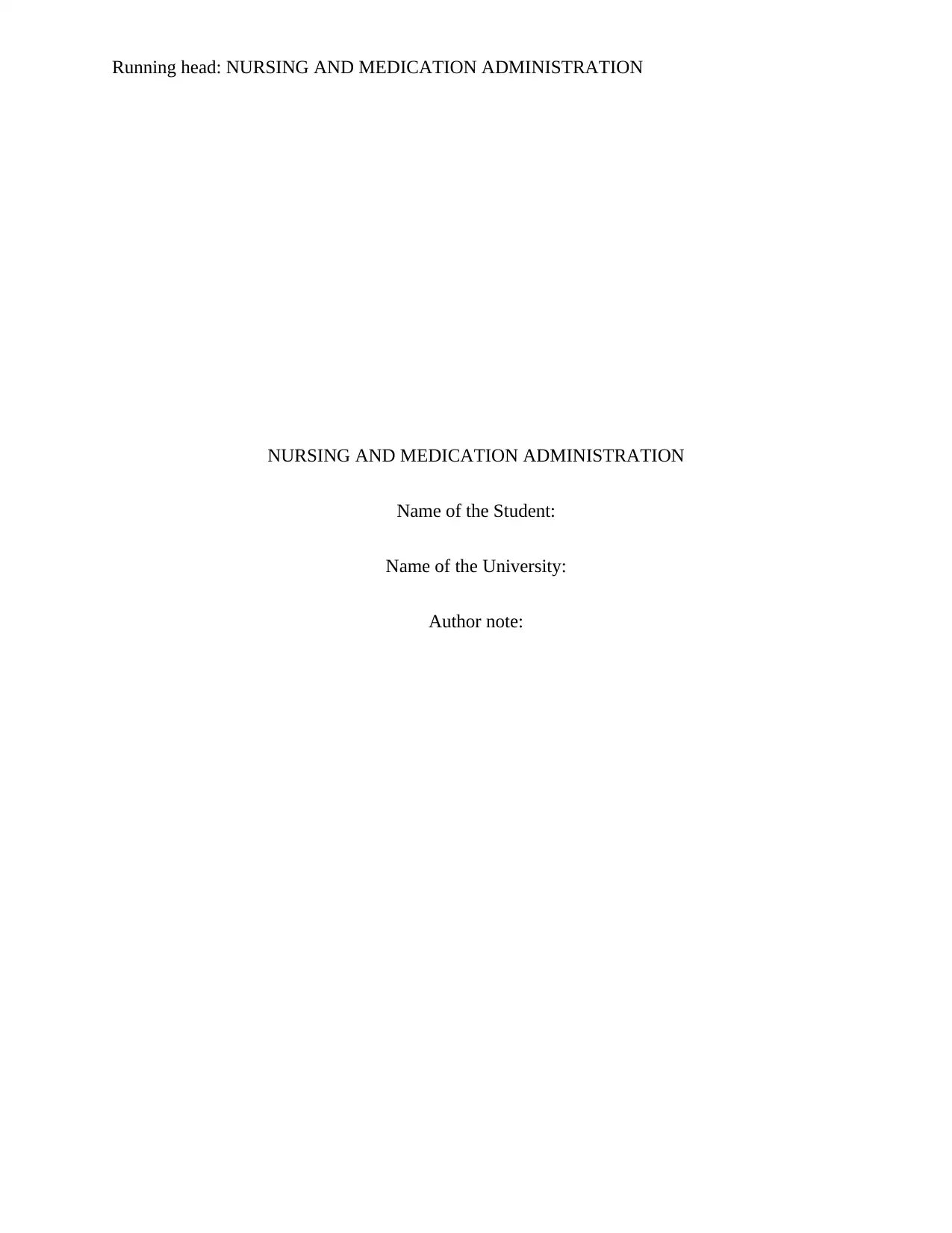
Running head: NURSING AND MEDICATION ADMINISTRATION
NURSING AND MEDICATION ADMINISTRATION
Name of the Student:
Name of the University:
Author note:
NURSING AND MEDICATION ADMINISTRATION
Name of the Student:
Name of the University:
Author note:
Paraphrase This Document
Need a fresh take? Get an instant paraphrase of this document with our AI Paraphraser
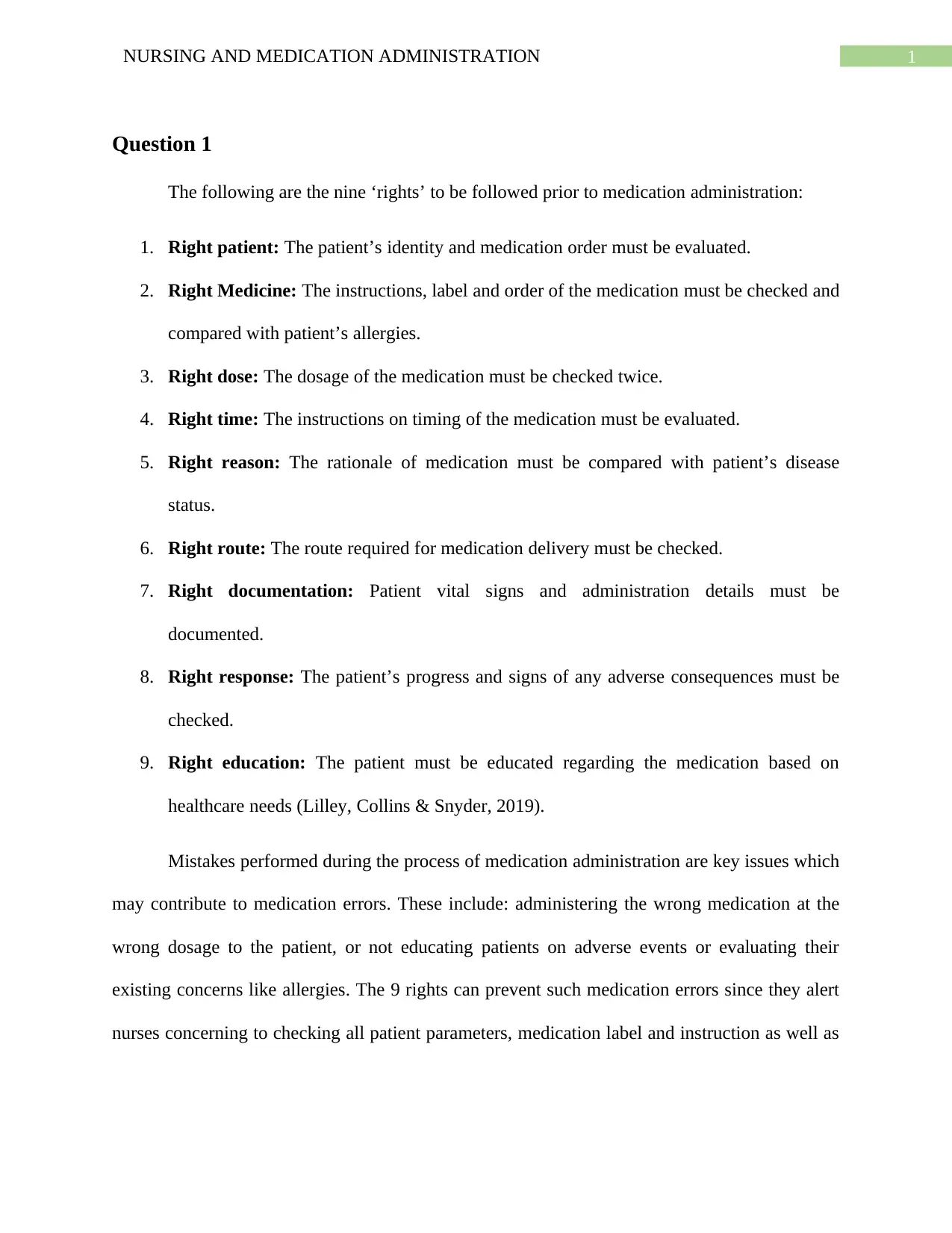
1NURSING AND MEDICATION ADMINISTRATION
Question 1
The following are the nine ‘rights’ to be followed prior to medication administration:
1. Right patient: The patient’s identity and medication order must be evaluated.
2. Right Medicine: The instructions, label and order of the medication must be checked and
compared with patient’s allergies.
3. Right dose: The dosage of the medication must be checked twice.
4. Right time: The instructions on timing of the medication must be evaluated.
5. Right reason: The rationale of medication must be compared with patient’s disease
status.
6. Right route: The route required for medication delivery must be checked.
7. Right documentation: Patient vital signs and administration details must be
documented.
8. Right response: The patient’s progress and signs of any adverse consequences must be
checked.
9. Right education: The patient must be educated regarding the medication based on
healthcare needs (Lilley, Collins & Snyder, 2019).
Mistakes performed during the process of medication administration are key issues which
may contribute to medication errors. These include: administering the wrong medication at the
wrong dosage to the patient, or not educating patients on adverse events or evaluating their
existing concerns like allergies. The 9 rights can prevent such medication errors since they alert
nurses concerning to checking all patient parameters, medication label and instruction as well as
Question 1
The following are the nine ‘rights’ to be followed prior to medication administration:
1. Right patient: The patient’s identity and medication order must be evaluated.
2. Right Medicine: The instructions, label and order of the medication must be checked and
compared with patient’s allergies.
3. Right dose: The dosage of the medication must be checked twice.
4. Right time: The instructions on timing of the medication must be evaluated.
5. Right reason: The rationale of medication must be compared with patient’s disease
status.
6. Right route: The route required for medication delivery must be checked.
7. Right documentation: Patient vital signs and administration details must be
documented.
8. Right response: The patient’s progress and signs of any adverse consequences must be
checked.
9. Right education: The patient must be educated regarding the medication based on
healthcare needs (Lilley, Collins & Snyder, 2019).
Mistakes performed during the process of medication administration are key issues which
may contribute to medication errors. These include: administering the wrong medication at the
wrong dosage to the patient, or not educating patients on adverse events or evaluating their
existing concerns like allergies. The 9 rights can prevent such medication errors since they alert
nurses concerning to checking all patient parameters, medication label and instruction as well as
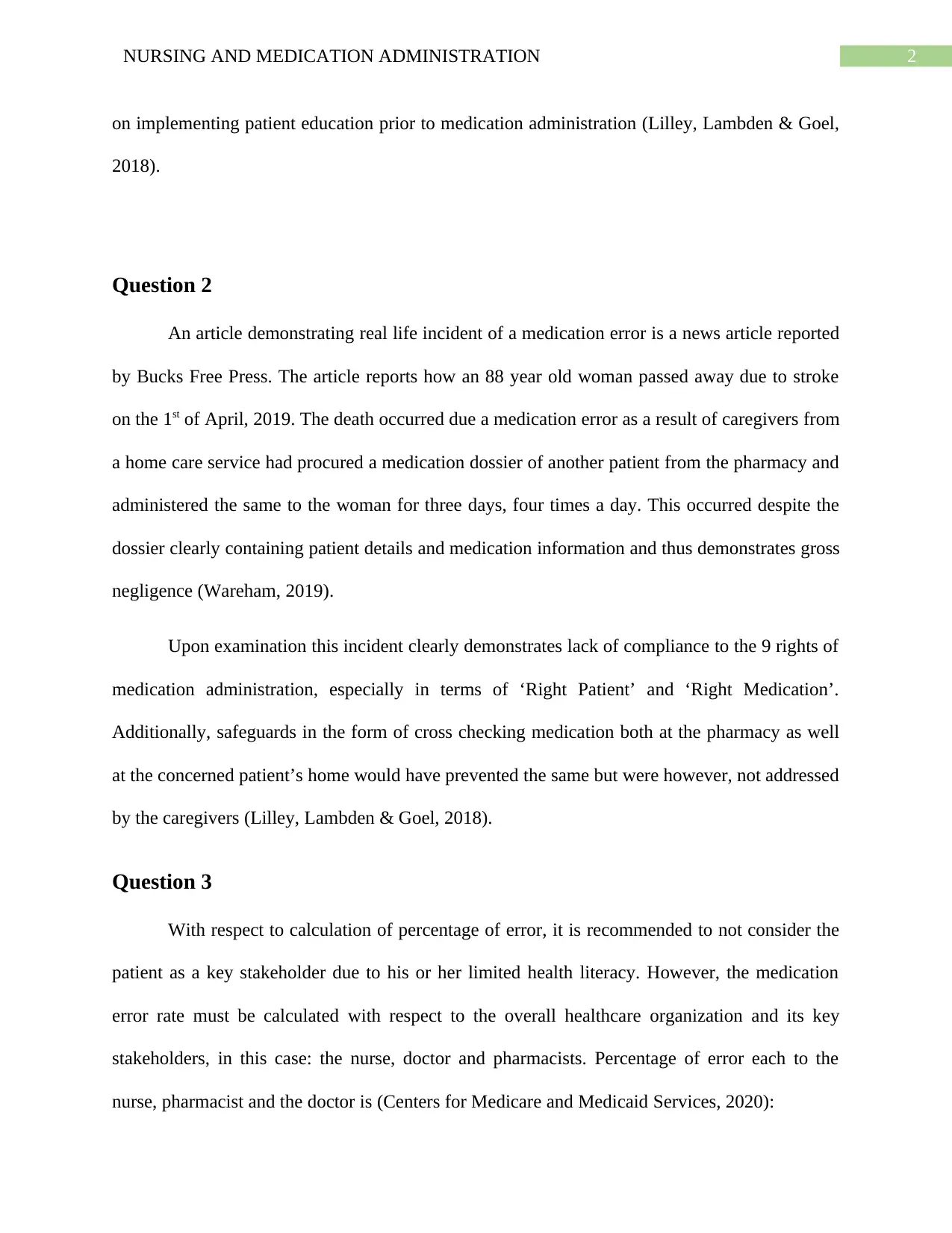
2NURSING AND MEDICATION ADMINISTRATION
on implementing patient education prior to medication administration (Lilley, Lambden & Goel,
2018).
Question 2
An article demonstrating real life incident of a medication error is a news article reported
by Bucks Free Press. The article reports how an 88 year old woman passed away due to stroke
on the 1st of April, 2019. The death occurred due a medication error as a result of caregivers from
a home care service had procured a medication dossier of another patient from the pharmacy and
administered the same to the woman for three days, four times a day. This occurred despite the
dossier clearly containing patient details and medication information and thus demonstrates gross
negligence (Wareham, 2019).
Upon examination this incident clearly demonstrates lack of compliance to the 9 rights of
medication administration, especially in terms of ‘Right Patient’ and ‘Right Medication’.
Additionally, safeguards in the form of cross checking medication both at the pharmacy as well
at the concerned patient’s home would have prevented the same but were however, not addressed
by the caregivers (Lilley, Lambden & Goel, 2018).
Question 3
With respect to calculation of percentage of error, it is recommended to not consider the
patient as a key stakeholder due to his or her limited health literacy. However, the medication
error rate must be calculated with respect to the overall healthcare organization and its key
stakeholders, in this case: the nurse, doctor and pharmacists. Percentage of error each to the
nurse, pharmacist and the doctor is (Centers for Medicare and Medicaid Services, 2020):
on implementing patient education prior to medication administration (Lilley, Lambden & Goel,
2018).
Question 2
An article demonstrating real life incident of a medication error is a news article reported
by Bucks Free Press. The article reports how an 88 year old woman passed away due to stroke
on the 1st of April, 2019. The death occurred due a medication error as a result of caregivers from
a home care service had procured a medication dossier of another patient from the pharmacy and
administered the same to the woman for three days, four times a day. This occurred despite the
dossier clearly containing patient details and medication information and thus demonstrates gross
negligence (Wareham, 2019).
Upon examination this incident clearly demonstrates lack of compliance to the 9 rights of
medication administration, especially in terms of ‘Right Patient’ and ‘Right Medication’.
Additionally, safeguards in the form of cross checking medication both at the pharmacy as well
at the concerned patient’s home would have prevented the same but were however, not addressed
by the caregivers (Lilley, Lambden & Goel, 2018).
Question 3
With respect to calculation of percentage of error, it is recommended to not consider the
patient as a key stakeholder due to his or her limited health literacy. However, the medication
error rate must be calculated with respect to the overall healthcare organization and its key
stakeholders, in this case: the nurse, doctor and pharmacists. Percentage of error each to the
nurse, pharmacist and the doctor is (Centers for Medicare and Medicaid Services, 2020):
⊘ This is a preview!⊘
Do you want full access?
Subscribe today to unlock all pages.

Trusted by 1+ million students worldwide
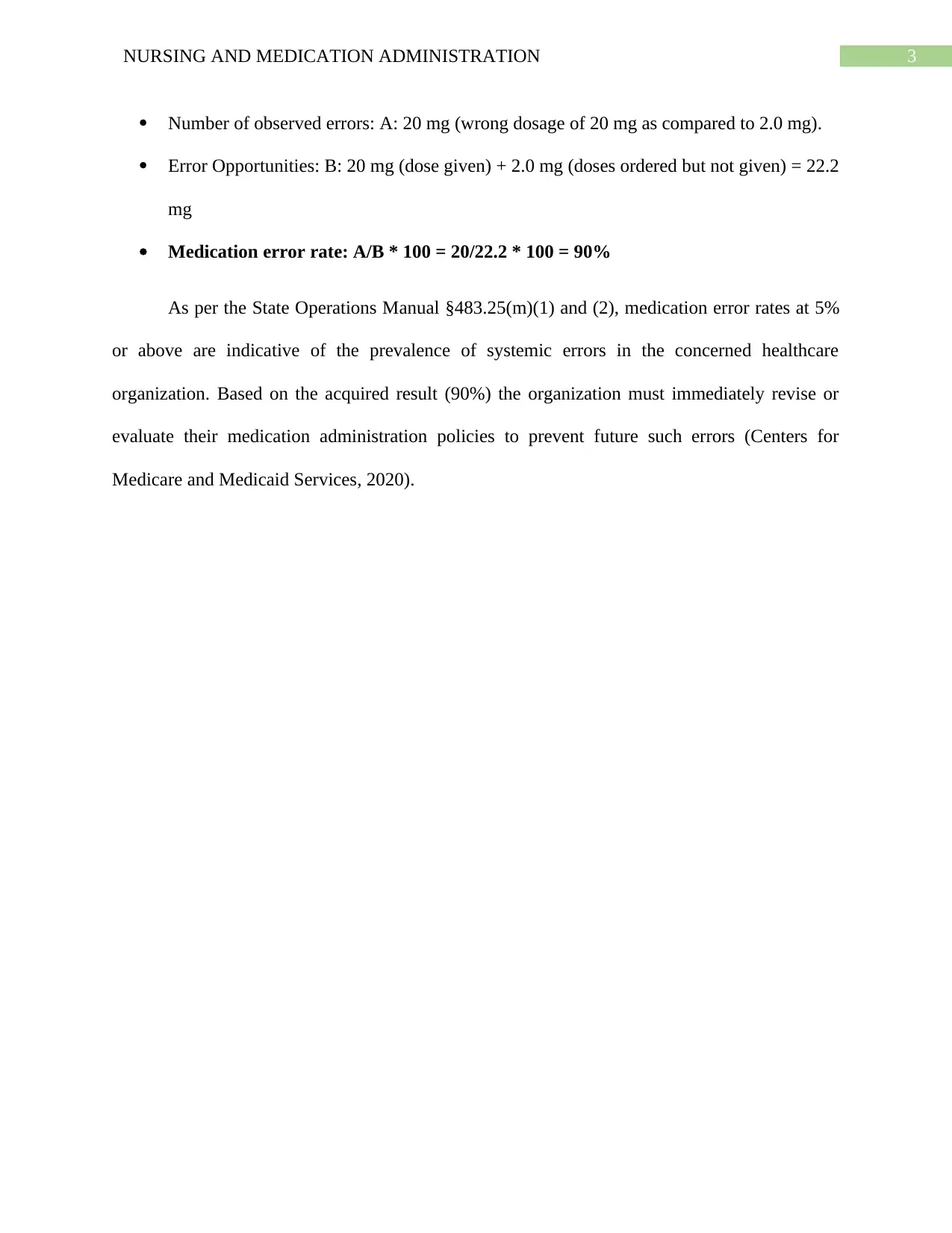
3NURSING AND MEDICATION ADMINISTRATION
Number of observed errors: A: 20 mg (wrong dosage of 20 mg as compared to 2.0 mg).
Error Opportunities: B: 20 mg (dose given) + 2.0 mg (doses ordered but not given) = 22.2
mg
Medication error rate: A/B * 100 = 20/22.2 * 100 = 90%
As per the State Operations Manual §483.25(m)(1) and (2), medication error rates at 5%
or above are indicative of the prevalence of systemic errors in the concerned healthcare
organization. Based on the acquired result (90%) the organization must immediately revise or
evaluate their medication administration policies to prevent future such errors (Centers for
Medicare and Medicaid Services, 2020).
Number of observed errors: A: 20 mg (wrong dosage of 20 mg as compared to 2.0 mg).
Error Opportunities: B: 20 mg (dose given) + 2.0 mg (doses ordered but not given) = 22.2
mg
Medication error rate: A/B * 100 = 20/22.2 * 100 = 90%
As per the State Operations Manual §483.25(m)(1) and (2), medication error rates at 5%
or above are indicative of the prevalence of systemic errors in the concerned healthcare
organization. Based on the acquired result (90%) the organization must immediately revise or
evaluate their medication administration policies to prevent future such errors (Centers for
Medicare and Medicaid Services, 2020).
Paraphrase This Document
Need a fresh take? Get an instant paraphrase of this document with our AI Paraphraser
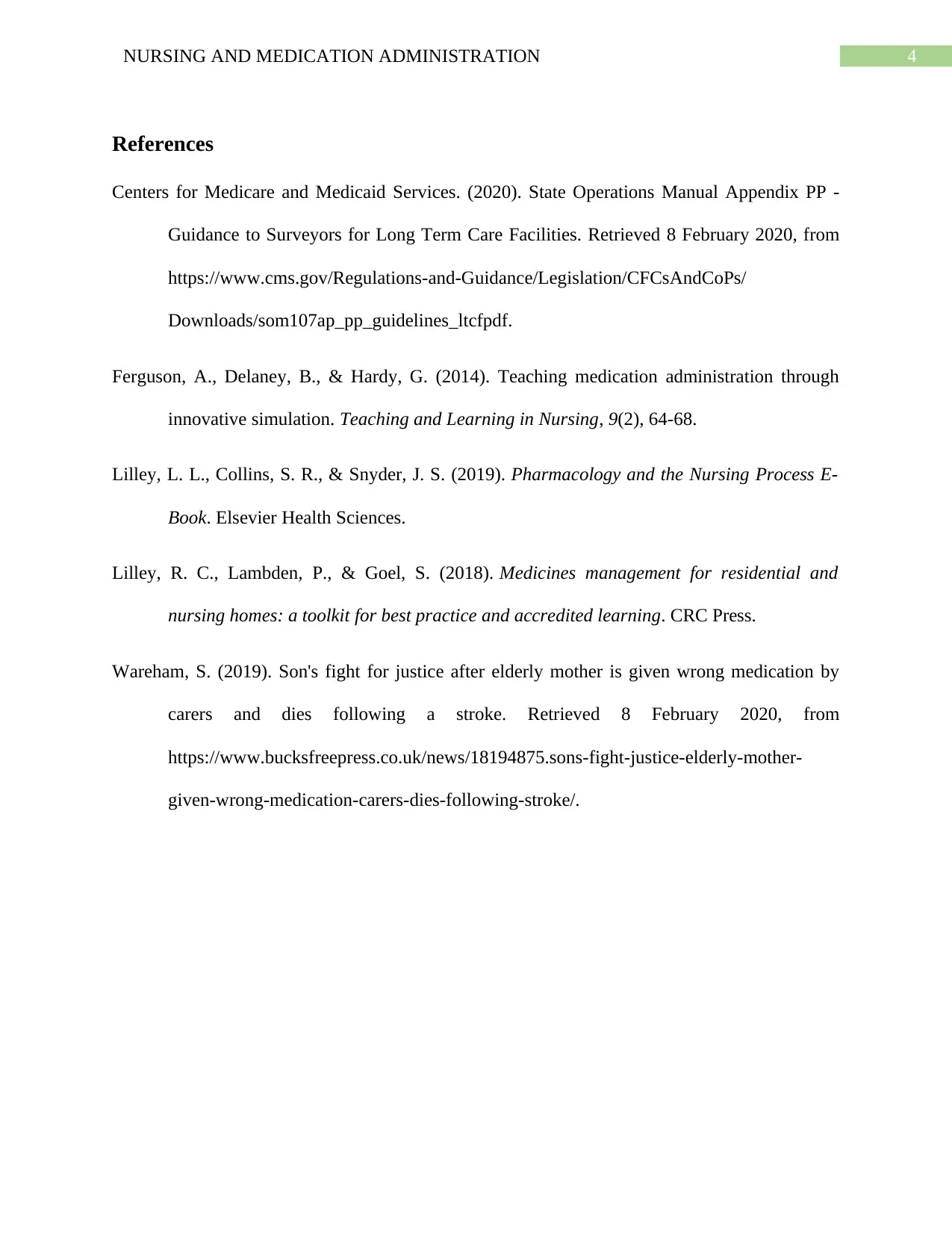
4NURSING AND MEDICATION ADMINISTRATION
References
Centers for Medicare and Medicaid Services. (2020). State Operations Manual Appendix PP -
Guidance to Surveyors for Long Term Care Facilities. Retrieved 8 February 2020, from
https://www.cms.gov/Regulations-and-Guidance/Legislation/CFCsAndCoPs/
Downloads/som107ap_pp_guidelines_ltcfpdf.
Ferguson, A., Delaney, B., & Hardy, G. (2014). Teaching medication administration through
innovative simulation. Teaching and Learning in Nursing, 9(2), 64-68.
Lilley, L. L., Collins, S. R., & Snyder, J. S. (2019). Pharmacology and the Nursing Process E-
Book. Elsevier Health Sciences.
Lilley, R. C., Lambden, P., & Goel, S. (2018). Medicines management for residential and
nursing homes: a toolkit for best practice and accredited learning. CRC Press.
Wareham, S. (2019). Son's fight for justice after elderly mother is given wrong medication by
carers and dies following a stroke. Retrieved 8 February 2020, from
https://www.bucksfreepress.co.uk/news/18194875.sons-fight-justice-elderly-mother-
given-wrong-medication-carers-dies-following-stroke/.
References
Centers for Medicare and Medicaid Services. (2020). State Operations Manual Appendix PP -
Guidance to Surveyors for Long Term Care Facilities. Retrieved 8 February 2020, from
https://www.cms.gov/Regulations-and-Guidance/Legislation/CFCsAndCoPs/
Downloads/som107ap_pp_guidelines_ltcfpdf.
Ferguson, A., Delaney, B., & Hardy, G. (2014). Teaching medication administration through
innovative simulation. Teaching and Learning in Nursing, 9(2), 64-68.
Lilley, L. L., Collins, S. R., & Snyder, J. S. (2019). Pharmacology and the Nursing Process E-
Book. Elsevier Health Sciences.
Lilley, R. C., Lambden, P., & Goel, S. (2018). Medicines management for residential and
nursing homes: a toolkit for best practice and accredited learning. CRC Press.
Wareham, S. (2019). Son's fight for justice after elderly mother is given wrong medication by
carers and dies following a stroke. Retrieved 8 February 2020, from
https://www.bucksfreepress.co.uk/news/18194875.sons-fight-justice-elderly-mother-
given-wrong-medication-carers-dies-following-stroke/.
1 out of 5
Related Documents
Your All-in-One AI-Powered Toolkit for Academic Success.
+13062052269
info@desklib.com
Available 24*7 on WhatsApp / Email
![[object Object]](/_next/static/media/star-bottom.7253800d.svg)
Unlock your academic potential
Copyright © 2020–2025 A2Z Services. All Rights Reserved. Developed and managed by ZUCOL.





